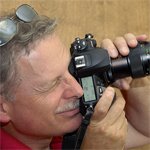Therefore, my strategy for purchasing lenses has changed for the better - pro glass to be more specific. With FX bodies on the rise, I expect to be shooting in that format within a year or two, so it was decisionmaking time regarding any new glass I would acquire. As a result, I have added two of the best zooms Nikon makes to my stable while shedding a handful of older DX and AI samples. They will perform beautifully on my current D300 and D40 DX bodies until I begin to acquire an FX body.

D200 with 14-24/2.8 Nikkor
A few 'for sale' posts were setup in photography forums this month to sell off my 18-70 Nikkor, 10-20 Sigma, a 35/2 AI Nikkor and an even older 135/28 AI'd Q Nikkor. (I've already liquidated other older lenses like the 180/2.8 AI, 70-300 ED and several pre-AF-S DX consumer zooms.) These recent sales netted me half the cash needed to finance my latest pro zoom, the new 14-24/2.8 G ED AF-S IF Nikkor. (When I realized the cost difference of just $300 between it and the otherwise excellent 17-55/2.8 DX Nikkor, it was a no-brainer.) As a new standard in superwide performance, this FX design effectively obsoletes the 14mm Nikkor prime, making this pro zoom a valid substitiute for all previous designs. Combined with the new 24-70/2.8 VR and 70-200/2.8 VR models, you have a full range of focal lengths that offer excellent wide open performance, high AF speed and top optical results under any circumstances.
This decision came on the heels of my first pro glass buy earlier this year - the 70-200/2.8G ED AF-S IF VR Nikkor - likely the most popular and first pro glass choice by most amateur/semipro shooters. Everyone seems to have one. Nothing prepared me for the image and build quality of this classic midrange tele. VR technology enables handheld or monopod shooting for much greater flexibility and response to imaging opportunities. And the wide open performance extends the use of lower ISO's under lower light levels. To my surprise, it also works beautifully with my $125 Kenko 1.4 Pro Teleconverter producing perfectly sharp images while retaining all lens functions.
This trend toward FX-ready optics is being followed by many forum participants who have run the course of prosumer glass and are also looking to the future now in their lens choices. If you never intend to graduate to an FX body, this is not necessary for producing excellent images - Nikon makes a number of DX zooms worthy of your attention. Several I like include the 17-55, 16-85 VR , and 70-300 VR. Although optically slower and offering lower performance wide open, they are more than sufficient for well lit subjects and flash photography.
Make no mistake - FX pro glass is an investment and any choices should be made with more care than we may have used with our DX choices. But each one is also a keeper - prized optics that will serve for a lifetime as we move into the FX format and offer a greater return over time.

10.5/2.8 Fisheye Nikkor
In addition to adding these two jewels to my kit, I became enamored with Nikon's 10.5/2.8G ED AF-D DX Fisheye Nikkor - a fullframe design with speed and sharpness to boot. Fortunately, I managed to acquire a perfect, used sample for 2/3 of the retail cost, making my potentially last DX lens purchase even sweeter. Presenting a whole new perspective on composition, I spent an exploratory afternoon shooting in downtown Knoxville, Tennessee, which you can view here: A Fisheye View of Knoxville.



No comments:
Post a Comment